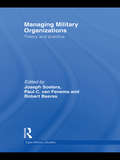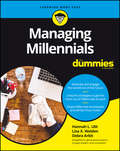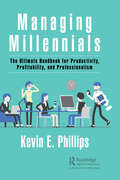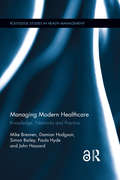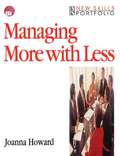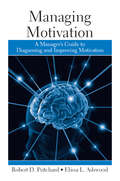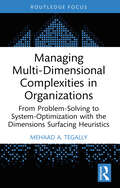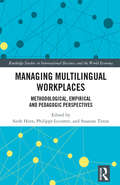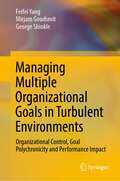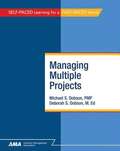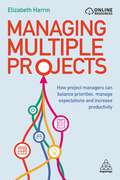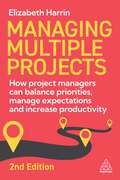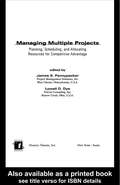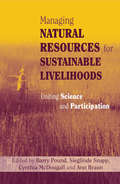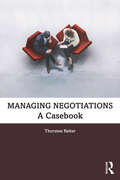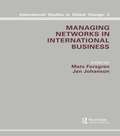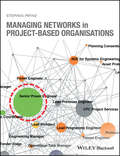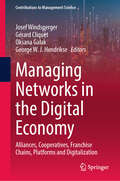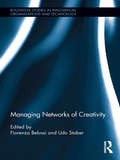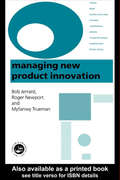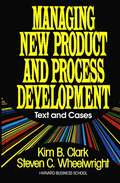- Table View
- List View
Managing Military Organizations: Theory and Practice (Cass Military Studies)
by Joseph SoetersThis book deals with the processes and theories involved in managing military organisations in both peacetime and crisis conditions. Examining the challenges faced by policymakers and military commanders in conducting military operations, this book considers the benefits of conventional management and organisation theory for the military. At the same time, these essays recognise that the military should be considered as a highly individual organisation, operating in exceptional circumstances. This awareness of the differences between the military and other organisations generates important lessons not only for the military but also for general organisations as it teaches them how to cope in exceptional, ‘hyper’ conditions. These theoretical lessons are illustrated by case studies and experiences from recent military operations, such as those in Iraq and Afghanistan. This book will be of great interest to students of military studies, security studies and organizational studies. Joseph Soeters chairs the department of management and organization studies and defence economy at the Netherlands Defense Academy and he is a professor in organizational sociology at Tilburg University. Paul. C. van Fenema is an associate professor of organization studies at the Netherlands Defence Academy and Tilburg University. Robert Beeres is an associate professor in the field of defence accounting and control (business administration) at the Netherlands Defence Academy and at Nyenrode Business School.
Managing Millennials For Dummies
by Debra Arbit Hannah L. Ubl Lisa X. WaldenEverything you need to harness Millennial potential Managing Millennials For Dummies is the field guide to people-management in the modern workplace. Packed with insight, advice, personal anecdotes, and practical guidance, this book shows you how to manage your Millennial workers and teach them how to manage themselves. You'll learn just what makes them tick—they're definitely not the workers of yesteryear—and how to uncover the deeply inspirational talent they have hiding not far below the surface. Best practices and proven strategies from Google, Netflix, LinkedIn, and other top employers provide real-world models for effective management, and new research on first-wave versus second-wave Millennials helps you parse the difference between your new hires and more experienced workers. You'll learn why flex time, social media, dress code, and organizational structure are shifting, and answer the all-important question: why won't they use the phone? Millennials are the product of a different time, with different values, different motivations, and different wants—and in the U.S., they now make up the majority of the workforce. This book shows you how to bring out their best and discover just how much they're really capable of. Learn how Millennials are changing the way work gets done Understand new motivations, attitudes, values, and drive Recruit, motivate, engage, and retain incredible emerging talent Discover the keys to optimal Millennial management The pop culture narrative would have us believe that Millennials are entitled, lazy, spoiled brats—but the that couldn't be further from the truth. They are the generation of change: highly adaptive, bright, and quick to take on a challenge. Like any generation of workers, performance lies in management—if you're not getting what you need from your Millennials, it's time to learn how to lead them the way they need to be led. Managing Millennials For Dummies is your handbook for allowing them to exceed your expectations.
Managing Millennials: The Ultimate Handbook for Productivity, Profitability, and Professionalism
by Kevin E. PhillipsThe Millennial workforce has different goals and objectives than previous generations and possesses a unique perspective that is unlike any other employee group. Nevertheless, instead of incorporating a management style that is conducive to getting the best out of Millennials, business leaders incorrectly attempt to manage this subset of the workforce the same way they manage employees from previous generations. This must change! Archaic methods of management do not deliver success with a new breed of employee. Instead, the outdated model leaves Millennials uninspired and lacking the desire to produce results. To get the best out of Millennials, it is imperative for leaders to modify their current management style. With over 55 million Millennials working in the United States, the largest demographic in the workplace, it is critical that they are managed effectively if companies are going to succeed. Managing Millennials: The Ultimate Handbook for Productivity, Profitability, and Professionalism delivers a profound understanding of what motivates Millennials, generates increased awareness of the different ideologies and preferences each generation in the workplace values, and most importantly, provides specific actions you can use to understand and motivate Millennials and transform your organization.
Managing Modern Healthcare: Knowledge, Networks and Practice (Routledge Studies in Health Management #2)
by John Hassard Simon Bailey Paula Hyde Mike Bresnen Damian HodgsonUntil now, research has given us only a limited understanding of how managers actually make sense of and apply management knowledge; how networks of interaction amongst managers help or hinder processes of knowledge diffusion and the sharing of best practice; and how these processes are all influenced both by the organisations in which managers act and by the professional communities of practice they belong to. Managing Modern Healthcare fills these important gaps in our understanding by drawing upon an in-depth study of management networks and practice in three healthcare organisations in the UK. It draws from the primary research a number of important and grounded lessons about how management networks develop and influence the spread of management knowledge and practice; how management training and development relates to the needs of managers facing challenging conditions; and how those conditions are themselves shaping the nature of management in healthcare. This book reveals how managers in practice are responding to the many contemporary challenges facing healthcare (and the NHS in particular) and how they are able or not to effectively exploit sources of knowledge, learning and best practice through the networks of practice they engage in to improve healthcare delivery and healthcare organisational performance. Managing Modern Healthcare makes a number of important theoretical contributions as well as practical recommendations. The theoretical and empirical contributions the book makes relate to wider work on networks and networking, management knowledge, situated learning/communities of practice, professionalization/professional identity and healthcare management more generally. The practical contribution comes in the form of recommendations for healthcare management practitioners and policy makers that are intended to impact upon and help enhance healthcare management delivery and performance.
Managing More with Less
by Joanna HowardManaging More with Less is an innovative book linking a range of core management skills and re-interpreting them to meet current organizational needs. Aimed at managers in flat organizations, this book shows you how to deal with increasingly scarce resources to maintain a high level of productivity. The New Skills Portfolio is a groundbreaking new series, published in association with the Industrial Society, which re-defines the core management skills managers and team leaders need to be competitive. Each title is action-focused blending management initiatives/trends with a new flexible skills portfolio.The Industrial Society is one of the largest public training providers in the UK. It has over 10,000 member organisations and promotes best practice through its publishing, consultancy, training and advisory services. For more information contact their website on www.indsoc.co.uk.
Managing Motivation: A Manager's Guide to Diagnosing and Improving Motivation
by Elissa Ashwood Robert PritchardThis slim motivation guidebook was written to bridge the gap between the academic research on motivation and to present it in a form that is useful to the practicing manager. In essence, the book presents a theory of motivation and how to use it without ever mentioning the word "theory". The goal of the book is to give managers a kind of mental model to use in thinking about motivation and to show them how to use this mental model for practical management actions to diagnose and improve motivation of subordinates. The book is written in three sections: Understanding Motivation, Diagnosing Motivation and Improving Motivation. The book incorporates case studies and many examples of how to successfully manage motivation.
Managing Multi-Dimensional Complexities in Organizations: From Problem-Solving to System-Optimization with the Dimensions Surfacing Heuristics (Systems Thinking)
by Mehaad A. TegallyPresenting a novel Systems Thinking methodology, this book serves as an essential guide to all those researching and practicing in a management, decision-making, or supervisory position who are facing multi-dimensional complex problems.The author presents critical systems thinking methods to address multi-dimensional complexities and deal with instability, uncertainty, and disruption. Complexities and perspectives are explained in simple terms to better understand the variety of influential factors of a complex situation, and meaningful insights into open-dynamic systems, their characteristics, purpose, and connections within the Eco-system, as well as thought-provoking behavioral ‘laws’ of systems, are presented. The author’s own tool “Dimensions Surfacing Heuristics” reveals and concurrently addresses the multiple dimensions of complex issues and paves the way to model its ideal state during system-optimization.The book is about seeing and understanding organizations as purposeful systems and about how to manage and optimize them. It will appeal to a scholarly audience across systems thinking, organizational studies, and management science as well as astute practitioners.
Managing Multi-Media Audiences at WHDH (Boston)
by V. Kasturi Rangan Thales S. TeixeiraWHDH's Channel 7 News rose to the #1 position in Boston-area news broadcasting through its embrace of an innovative format and affiliating with NBC. Since the early 2000s, however, other news programs had copied their format, and young audiences had begin to use the Internet to get their news, dramatically cutting ratings and ad revenue. Station owner Edmund Ansin and general manager Chris Wayland faced a choice of whether to use the TV news to push viewers to the station's website and monetize online, or use an online presence to build loyalty to Channel 7 and thus drive viewers to TV.
Managing Multilingual Workplaces: Methodological, Empirical and Pedagogic Perspectives (Routledge Studies in International Business and the World Economy)
by Susanne Tietze Sierk Horn Philippe LecomteThis book sets new trajectories for language-sensitive business and management research and pedagogy. The existence of language plurality characterises these. Empirical studies have been established as important and relevant for contemporary research. It has shifted language-sensitive research from the periphery to the centre of international management research. However, this field is rapidly changing, and new thematic approaches have begun to emerge. By addressing this, the book offers genuine and more nuanced insights into existing themes and comes with applications of emergent conceptual developments in different settings. The second part of the book covers methodologies and gives examples and cutting-edge insights into the role of translation in the execution of empirical research and theorising arising from it. Finally, the book draws together innovative ways of how to address the challenges of a multilingual teaching classroom and how to innovate in order to incorporate such diversity through pedagogic practice. This book provides a source that unites insights from multilingual empirical research, methodological considerations and pedagogic practice in order to advance knowledge and debate. It will be a ‘handy source’ of information that offers direct access to the latest guidance on language-sensitive management challenges. It will, therefore, appeal to an internationally-minded and mobile audience, including scholars, students and decision-makers.
Managing Multiple Organizational Goals in Turbulent Environments: Organizational Control, Goal Polychronicity and Performance Impact
by Feifei Yang Mirjam Goudsmit George ShinkleThis book examines the management of multiple goals in organizations especially in today's increasingly turbulent business environment. In this book, authors develop a novel concept of goal polychronicity, wherein organizations may attend to multiple goals simultaneously, rather than mono-chronically through sequential attention. This book further investigates the impact of internal organizational control systems and external environmental turbulence on multiple goals management. Empirical evidence is drawn from in-depth interviews of top executives and large-scale survey of top executives from four countries (US, Australia, China, and Israel). The book enriches the understanding of multiple goals and provides evidence-based recommendations to researchers and practitioners in managing multiple goals.
Managing Multiple Projects
by Michael S. Dobson Deborah S. DobsonLet’s face it — who among us has only a single project? Multiple projects are the norm, not the exception, and there are very good reasons why this is so. A lot of projects simply aren’t big enough to justify the investment of a full-time project manager: having only one is impractical. Depending on the availability of resources, a multiple project environment can accomplish substantial work while lowering the overhead burden of project management by consolidating processes. In this book, you will learn how to recognize the characteristics and to manage effectively in each of these situations, how to plan and organize your work, how to influence other people who may not report to you in an official supervisory capacity, and how to get results. This is an ebook version of the AMA Self-Study course. If you want to take the course for credit you need to either purchase a hard copy of the course through amaselfstudy.org or purchase an online version of the course through www.flexstudy.com.
Managing Multiple Projects: How Project Managers Can Balance Priorities, Manage Expectations and Increase Productivity
by Elizabeth HarrinProject management is changing. Rather than focusing solely on one large project, the majority of project managers are now expected to juggle multiple projects, which brings a different set of challenges. Between a greater number of project sponsors, resource conflicts and constant pressure from deadlines, it can be difficult to avoid burnout. Managing Multiple Projects blends formal project management techniques with time management and productivity tools in a step-by-step approach to consolidating your workload. From combining schedules to prioritising work and engaging stakeholders, this book clearly explains how to adapt your behaviour and techniques to successfully work on several projects at once.This practical guide provides answers to commonly asked questions (such as how to reduce the number of meetings and how to manage a To Do list) and includes case studies from real project managers. Checklists for common tasks and adaptable templates of trackers and reports are combined with easily actioned exercises to improve processes. Managing Multiple Projects gives practitioners the tools they need to improve the chances of project success and maintain a work-life balance. Online resources include downloadable templates of productivity checklists and status reports.
Managing Multiple Projects: How Project Managers Can Balance Priorities, Manage Expectations and Increase Productivity
by Elizabeth HarrinProject management is becoming even more complex. Every project manager, regardless of their industry, will be taking on an increasing number of projects bringing a new set of challenges for them to navigate.Combining an overview of formal project management techniques with strategies for time management and productivity, Managing Multiple Projects is an essential guide for project managers to understand how to balance priorities, manage expectations and increase productivity while managing multiple projects at once. This second edition is fully updated and draws on the latest trends in project management. From managing hybrid project teams to integrating change management techniques, this book includes content on how to work with AI and robotic process automation as well as guidance on balancing multiple methodologies, offering the key to working in the new project ecosystem.Checklists for common tasks and adaptable templates of trackers and reports are provided alongside easily actioned exercises to improve processes. Managing Multiple Projects has the tools needed to improve the chances of project success and get results. The book also includes online resources including downloadable templates of framework checklists and status reports.
Managing Multiple Projects: Planning, Scheduling, and Allocating Resources for Competitive Advantage
by James S. Pennypacker Lowell D. DyeProject leaders, managers, and team members, as well as cost engineers, analysts, and students in project management and planning, can glean ideas and methods for managing multiple projects from this reference. It details time-efficient and cost-effective strategies for evaluating, selecting, prioritizing, planning, and managing multiple projects. The editors present proven methods and practical applications for the development of successful project portfolios and prosperous multi-project environments. Edited by pioneers in the field, with contributions from a panel of experts, the book provides useful models and scheduling frameworks for increased quality and productivity.
Managing Museums and Galleries
by Michael FoppThe current economic climate, coupled with an all embracing desire for museums to be respondent to 'the market' make a proper grounding in management essential. The 'bottom line' is one of the most powerful measures of management performance. Museums and galleries invariably have a neutral bottom line, they are not set up to make a profit and many of them are constrained by governmental accounting rules and charity legislation. Managing these organisations is difficult and this book tackles the issues that make it easier. Managing the Museum examines the highly sophisticated principles and techniques of modern business management from the perspective of museums and galleries and delineates their practical application. This volume surveys the day-to-day issues of time management, delegation and recruitment to the problems of strategic planning and initiating and controlling conflict and change. This study incorporates the needs of both the independent and national sectors and discusses the links between the museum and commerce.
Managing Natural Resources for Sustainable Livelihoods: Uniting Science and Participation
by Cynthia McDougall Barry PoundManagement of local resources has a greater chance of a sustainable outcome when there is partnership between local people and external agencies, and agendas relevant to their aspirations and circumstances. Managing Natural Resources for Sustainable Livelihoods analyses and extends this premise to show unequivocally that the process of research for improving natural resource management must incorporate participatory and user-focused approaches, leading to development based on the needs and knowledge of local resource users. Drawing on extensive and highly relevant case studies, this book presents innovative approaches for establishing and sustaining participation and collective decision-making, good practice for research, and challenges for future developments. It covers a wide range of natural resources - including forests and soils, and water and management units, such as watersheds and common property areas - and provides practical lessons from analysis and meta-analysis of cases from Asia, Africa and Latin America. It offers insights on how to make research participatory while maintaining rigour and high-quality biological science, different forms of participation, and ways to scale up and extend participatory approaches and successful initiatives. This book will be invaluable for those professionally involved in natural resource management for sustainable development and an essential resource for teachers and students of both the biophysical and social science aspects of natural resource management.
Managing Natural and Cultural Heritage for a Durable Tourism
by Anna Trono Valentina Castronuovo Petros KosmasThis contributed volume offers a wealth of cases that explore the factors and conditions required for heritage tourism to be economically and socially beneficial to local communities without impairing the natural environment, cultural heritage preservation, or sustainability for future generations. The studies presented here comprise an examination of measures which have been and can be implemented to ensure sustainable use of natural and cultural systems, leading to a new concept of tourism that incorporates science and community practices together to create a favorable environment where tourists and locals can experience meaningful interactions and experiences. The book focuses on the role of stakeholders in the development of a new policy regarding the sustainable management of cultural tourism and the possibility of their involvement in the processes governing policy-making. Emphasis is placed on the role and commitment of local and international authorities, including UNESCO, in preserving the world's endangered cultural and natural heritage, as well as the responsibilities of Member States and public and private actors with respect to future conservation challenges.
Managing Negotiations: A Casebook
by Thorsten ReiterManaging Negotiations is a collection of seven global, real-life case studies on prominent negotiations in the realm of international business and politics. The book combines the rigorously researched frameworks of academia with the real-world challenges of negotiations. The cases combine scientific negotiation management practices as well as theories with real-world examples that demonstrate how to conduct successful negotiations and which prominent pitfalls to avoid. The topics discussed reach from mergers & acquisitions, collective bargaining, international diplomatic treaties to international free trade agreements. Each case study starts with an overview comprising three key objectives and ends with the key learnings as well as reflective questions for class discussion. This casebook can be used as recommended reading on Negotiation and Strategic Management courses at postgraduate, MBA and Executive Education level and serves as a guide for practitioners responsible for contract management, negotiation and procurement.
Managing Negotiators: How Do You Steer Them Toward Deals Worth Doing?
by Danny Ertel Mark GordonNegotiation may seem like the last unmanageable frontier in business yet even star negotiators need guidance and management. This chapter includes coaching questions and competency guides to help in your management of negotiators.
Managing Networks in International Business
by M. Forsgren J. JohansonThe book introduces a unique and innovative perspective for the study of international business networking. In contrast to the standard construction of models for optimal strategic decision-making, the essays in this book emphasise interpretation, learning by doing, trust and co-operation in the international business community. The editors focus upon business relationships within and between firms as well as the importance of middle management in the international arena.
Managing Networks in Project-Based Organisations
by Stephen PrykeThe first book demonstrating how to apply the principles of social network analysis to managing complex projects This groundbreaking book gets project managers and students up to speed on state-of-the-art applications of social network analysis (SNA) for observing, analysing, and managing complex projects. Written by an expert at the leading edge of the SNA project management movement, it clearly demonstrates how the principles of social network analysis can be used to provide a smarter, more efficient, holistic approach to managing complex projects. Project managers, especially those tasked with managing large, complex construction and engineering projects, traditionally have relied upon analysis and decision-making based upon hierarchical structures and vaguely defined project systems, much of which is borrowed from historic scientific management approaches. However, it has become apparent that a more sophisticated methodology is required for observing project systems and managing relationships with today’s more knowledgeable and demanding clients. Social network analysis (SNA) provides just such an approach. Unfortunately, existing books on social network analysis are written primarily for sociologists and mathematicians, with little or no regard for the needs of project managers — until now. The first and only book of its kind, Managing Networks in Project-Based Organisations: Offers a framework and a fully-developed approach to applying SNA theory and methodologies to large, complex projects Describes highly effective strategies and techniques for managing the iterative and transient relationships between network-defining actor roles involved in the delivery of complex projects Uses numerous real-world examples and case studies of successful applications of SNA to large-scale construction and engineering projects around the world Draws on its author’s decades of experience managing complex projects for demanding clients, as well as his extensive academic research in Project Management Managing Networks in Project-Based Organisations is an important working resource for project management professionals and consultants, especially those serving the construction and engineering industries. It is also an excellent text/reference for postgraduate students of project management and supply chain management, as well as academic researchers of project management.
Managing Networks in the Digital Economy: Alliances, Cooperatives, Franchise Chains, Platforms and Digitalization (Contributions to Management Science)
by Gérard Cliquet Josef Windsperger George W. J. Hendrikse Oksana GalakThis book presents recent developments in the theory and management of networks (such as alliances, cooperatives, franchise chains) and platforms. In addition, it explores the impact of digitalization on networks and presents empirical studies on digital platform businesses. The book will be of major interest to scholars and students of economics of organization, business and management, governance of networks and digital platforms, and practicing managers.
Managing Networks of Creativity (Routledge Studies in Innovation, Organizations and Technology)
by Udo Staber Fiorenza BelussiThe aim of the Managing Networks of Creativity is to improve our understanding of creativity and the management of creativity, as discussed in the fields of management (including strategic management, organization science, organizational behaviour, and entrepreneurship), economics, sociology, regional studies, and political science. While research on creativity has made several important contributions to the theoretical literature, little attention has been paid to the development and testing of formal theoretical models, especially in those cases where creativity is the result not so much of individual behaviour than the outcome of collective efforts, connecting individuals in organizations, social networks, projects, geographic clusters, and so forth. The proposed volume includes studies, both conceptual and empirical, which, as a whole, "deconstruct" the concept of creativity and the management of creativity by identifying specific situations, contexts, firms, clusters, and districts in which creative processes evolve. The reader is provided with in-depth discussions of theoretical issues and a range of descriptive cases and survey data that the authors use to explore or test concepts and models. Overall, the volume aims to integrate current debates concerning the role of creativity (and innovation) in economic and social development.
Managing New Product Innovation
by Bob Jerrard Myfanwy Trueman Roger NewportNew product design and development is often the result of personal vision. Harnessing this often requires a special receptiveness and enthusiasm at all levels of an organization, which serves to unlock potential and can turn the entire organizational pyramid upside-down. It is particularly important to understand and develop those aspects of design which can be constructively employed by designers in a strategic alliance with management and research.; The papers in this volume result from the conference of the Design Society held at the University of Central England in September 1998. They show how design-led product development has worked in a range of industries, from engineering through to design and management consultancy.
Managing New Product and Process Development
by Steven C. WheelwrightArgues that a company's capability to conceive and design quality prototypes and bring a variety of products to market more quickly than its competitors is increasingly the focal point of competition. The authors present principles for developing speed and efficiency.
